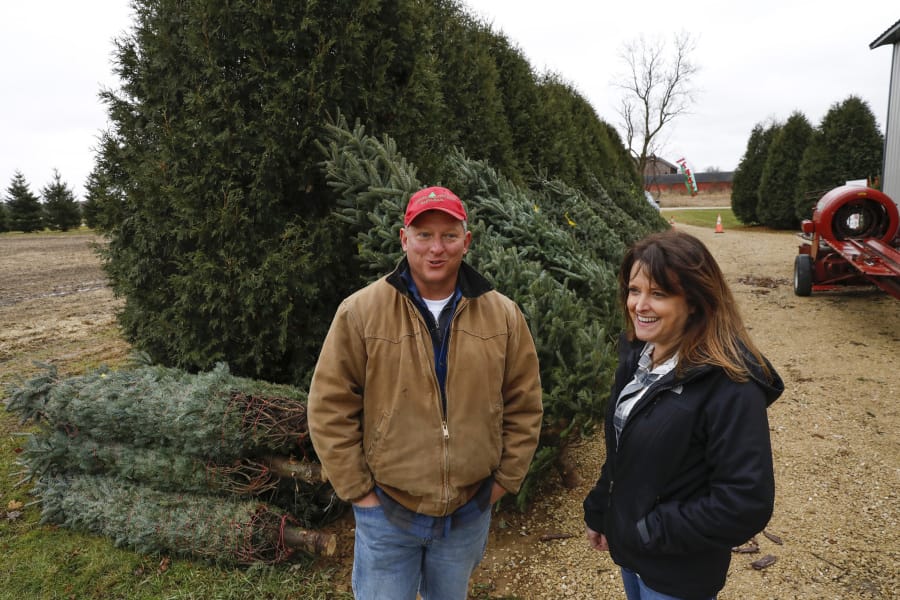John Minalt, 54, has spent most of his professional career as a dentist, but on the weekends he prepares for the seasonal rush of Christmas tree shoppers.
For the past 10 years, Minalt has been growing trees on his 20-acre Conifera Tree Farm in Harvard, Ill., more than 70 miles northwest of Chicago.
Minalt is coming up on his third year selling balsam fir, fraser fir, spruce and white pine trees, but by tree farming standards, he’s just getting started. Most farmers don’t see a profit until seven to 10 years in because of how long it takes trees to grow.
Minalt says he isn’t the only one cleaning teeth and planting Christmas trees. He knows of at least one more dentist-farmer in Illinois and another from Wisconsin.
“It’s funny. I’m not the only one in the state. There are several others like me,” Minalt said.
But that could soon change. Across the U.S., Christmas tree farmers are getting out of the business. Illinois lost dozens of farmers in recent years, dropping from 212 growers in 2012 to 182 farmers in 2017, according to the latest U.S. Department of Agriculture census data.
James Farmer, an Indiana University professor who led a study that looked at farmers in the Hoosier State, said younger farmers aren’t taking the place of those who are retiring. Most growers in Indiana have plans to stop growing or planting trees in the next five years, Farmer said.
“The average farmer was 64 years old. A lot of folks get into Christmas tree farming and start planting trees when they are older. Most of them have smaller operations. But by the time they hit their mid-70s, they get out,” Farmer said.
The physical demands of tree farming can discourage growers from continuing the business, as can the amount of time it takes to turn a profit. About 30 percent of Indiana farmers reported revenues of $10,000 or less in 2017, the study found. And selling Christmas trees is a part-time endeavor for most growers.
Chris Czarnowski, 43, is the owner of Ben’s Christmas Tree Farm in Harvard. Czarnowksi runs an information technology consultancy firm and recently hired a manager to oversee the farm, which offers horse-drawn wagon rides and a petting zoo in addition to selling trees.
“We have more customers looking for an experience. That’s what we focus on,” Czarnowski said.
The farm opened the Friday after Thanksgiving, a critical time for the business because it’s when families are picking their trees, Czarnowski said. With only a few weeks to make sales, Czarnowski said he has to compete with other events and weather that could pull consumers away.
“It’s a tough business to be in. You are only open a couple of times a week. If the (Chicago) Bears are playing, you are not going to get a good turnout,” Czarnowski said.
Christmas tree farmers have also been hit by another competitor. Artificial trees sales have been steadily increasing, with 24 million purchased last year compared to about 21 million purchased in 2017, according to data by the National Christmas Tree Association.
“In the last few years, they have taken over a large percentage of the market. It’s hurt us more than we realized,” said Doug Hundley, a seasonal spokesman for the association.
Last year, the average price of a live Christmas tree was $78, and the average cost of an artificial one was $104, according to the 2018 consumer report by the association.
Older consumers who no longer have children living in the household tend to shift to artificial trees or don’t put one up, Hundley said. But there is demand from younger families who drive to farms to pick and cut their own tree. According to the association, 28 percent of the live Christmas trees purchased in 2018 were bought at farms.
“We think sales increase is coming from millennials,” Hundley said.
Larger farming operations that sell to big-box retailers like Costco, Home Depot and Lowe’s have hurt sales at garden centers and parking lot vendors, once popular with urban residents looking to buy live trees, Hundley said.
“When they found out that big retailers were setting up their own Christmas tree lot, they were not happy,” Hundley said of the smaller vendors. “It flooded the market. But if you are a small garden center or a tree lot, you will have a lot more things to offer like customer service.”
Larger growers can sell as many as 200,000 trees to big-box stores, Hundley said. Some 28 percent of shoppers say they bought at a chain store last year, according to data from the association.
“It’s given bigger growers an easy place to sell a lot of trees,” he said.
Lowe’s and Costco buy from a variety of farmers, though they declined to say whether they primarily rely on larger growers. Lowe’s purchases Christmas trees from suppliers in North Carolina, Virginia, Pennsylvania, Michigan, Oregon, Washington and some from Canada, Robert Sedlatschek, the company’s divisional merchandising manager of live goods, said in an email.
Minalt, who operates a choose-and-cut farm, said he orders pre-cut trees he can’t grow from Wisconsin. Customers tend to like the trees with longer needles and ones that are much taller, Minalt said. The supply also helps during spells of bad weather.
“May was terrible,” Minalt said about one of the wettest months in years. “We had fields that were flooded. We planted about 5,400 and lost 1,400, but we make up for it from the trees we get from Wisconsin.”
Despite the challenges, Minalt said he’ll continue to operate his farm.
“I love it and I enjoy doing it. When people come out, it’s a nice family experience,” Minalt said “There’s nothing like the smell of a fresh tree.”



